Manishtushu
Manishtushu (𒈠𒀭𒅖𒌅𒋢, Ma-an-ish-tu-su)[2] was the third king of the Akkadian Empire, reigning from c. 2270 BC until his assassination in 2255 BC (Middle Chronology).[3] He was the son of Sargon the Great, the founder of the Akkadian Empire, and he was succeeded by his son, Naram-Sin.
| Manishtushu 𒈠𒀭𒅖𒌅𒋢 | |
|---|---|
| |
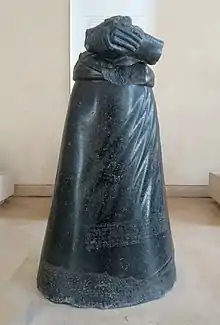 Statue of Manishtusu. The inscription on the robe is in Elamite, added in the 12th century BCE. According to it, the statue was taken from Akkad and brought to Susa in the 12th century BCE by king Shutruk-Nakhunte.[1] Louvre Museum | |
| King of the Akkadian Empire | |
| Reign | c. 2270 BC – 2255 BC |
| Predecessor | Rimush |
| Successor | Naram-Sin |
| Issue | Naram-Sin |
| Father | Sargon of Akkad |
| Mother | Tashlultum |
Biography
Manishtushu was the third king of the Akkadian Empire. He was the son of Sargon of Akkad and Queen Tashlultum, brother of En-hedu-ana, Rimush, and Shu-Enlil, and the father of Naram-Sin.
He became king in c. 2270 BC after the death of his brother Rimush. Manishtushu, freed of the rebellions of his brother's reign, led campaigns to distant lands. According to a passage from one of his inscriptions, he led a fleet down the Persian Gulf where 32 kings allied to fight him. Manishtushu was victorious and consequently looted their cities and silver mines, along with other expeditions to kingdoms along the Persian Gulf.[4] He also sailed a fleet down the Tigris River that eventually traded with 37 other nations, conquered the city of Shirasum in Elam, and rebuilt the destroyed temple of Inanna in Nineveh in c. 2260 BC. In Elam and Pashime, in the coastal area of Iran, Manishtushu had governors installed for the Akkadian Empire: Eshpum was in charge of Elam, while Ilshu-rabi was in charge of Pashime.[5][6][7]
In c. 2255 BC Manishtushu died, assassinated by members of his own court, and was succeeded by his son Naram-Sin. A pyramidal stele erected by Manishtushu bearing a long cuneiform inscription in Akkadian is featured in the Louvre.[8]
He held the title "King of Kish" in some of his inscriptions.[9]
Manishtushu trampling enemies
A probable statue of Manishtushu discovered in Susa, Elam, shows him trampling vanquished enemies. There are inscriptions on the bodies of the enemies, identifying them.[10] The statue is in the Louvre Museum (Sb 48).[11]
.jpg.webp) Remain of the statue
Remain of the statue.jpg.webp) Enemy being trampled
Enemy being trampled.jpg.webp) Enemy being trampled
Enemy being trampled
Other artifacts
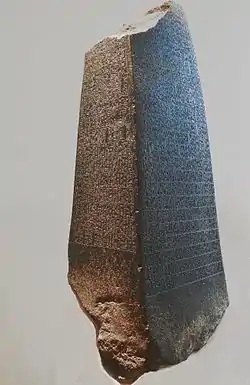 Manishtushu Obelisk, Louvre Museum.[12]
Manishtushu Obelisk, Louvre Museum.[12]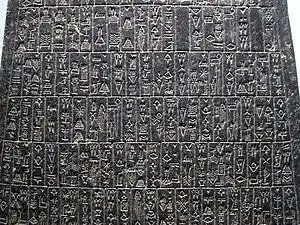 Detail of inscription on the obelisk
Detail of inscription on the obelisk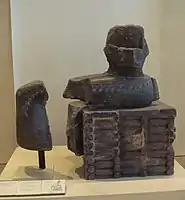 Throne of Manishtushu, Louvre Museum
Throne of Manishtushu, Louvre Museum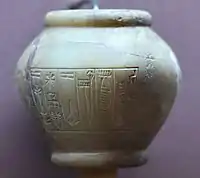 Votive stone mace-head in the name of Manishtushu, from Uruk, Iraq. 2270-2255 BCE. Iraq Museum.
Votive stone mace-head in the name of Manishtushu, from Uruk, Iraq. 2270-2255 BCE. Iraq Museum. Macehead inscription of Manishtushu: Manishtushu Lugal Kish, "Manishtushu King of Kish"
Macehead inscription of Manishtushu: Manishtushu Lugal Kish, "Manishtushu King of Kish"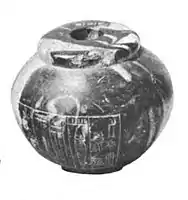 Macehead in the name of Manishtushu, British Museum, BM 91018
Macehead in the name of Manishtushu, British Museum, BM 91018
See also
| Regnal titles | ||
|---|---|---|
| Preceded by Rimush |
King of Akkad King of Kish, Uruk, Lagash, and Umma Overlord of Elam ca. 2205 - 2191 BC (short) |
Succeeded by Naram-Sin |
References
- Harper, Prudence O. (1992). Royal City of Susa: Ancient Near Eastern Treasures in the Louvre. Metropolitan Museum of Art. p. 165.
- "Mace head of Manishtusu". British Museum.
- "Obelisk". The Louvre. Retrieved 17 May 2016.
- Samuel Noah Kramer (2010-09-17). The Sumerians: Their History, Culture, and Character. University of Chicago Press. ISBN 978-0-226-45238-8.
- Potts, D. T. (1999). The Archaeology of Elam: Formation and Transformation of an Ancient Iranian State. Cambridge University Press. p. 106. ISBN 978-0-521-56496-0.
- Bryce, Trevor (2009). The Routledge Handbook of the Peoples and Places of Ancient Western Asia: From the Early Bronze Age to the Fall of the Persian Empire. Taylor & Francis. p. 533. ISBN 978-0-415-39485-7.
- Álvarez-Mon, Javier; Basello, Gian Pietro; Wicks, Yasmina (2018). The Elamite World. Routledge. p. 711. ISBN 978-1-317-32983-1.
- "Obelisk". The Louvre. Retrieved 17 May 2016.
- "CDLI-Archival View". cdli.ucla.edu.
- Amiet, P. (1972). "Les Statues de Manishtusu, Roi d'Agadé". Revue d'Assyriologie et d'archéologie orientale. 66 (2): 103–105. ISSN 0373-6032. JSTOR 23295860.
- "Site officiel du musée du Louvre". cartelfr.louvre.fr.
- Full transcription of the Manishtusu obelisk: "CDLI-Archival View". cdli.ucla.edu.